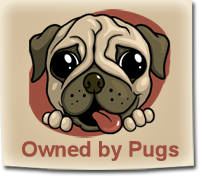Introducing your Pug Puppy to training Part 1
By George Cockrell
June 5th, 2004
As a Professional Dog trainer, I come into contact with new dog owners who wish to start things off in the right direction. There are just as many ways to do so as there are breeds it seems. As a new Pug owner, there are a few things that should be considered due to your flat faced friend's unique physical attributes.
First things first. A new Leash and collar will certainly be on your shopping list. There are literally thousands of options for one at the local pet store. It's important to remember that any collar does not equal a good training collar. The collars described here are for the actual training of your Pug to respond to commands and become a well mannered dog.
The advice we offer to the Pug owners is to avoid training collars that constrict when pulled, at least for the first several months. Constriction collars include the following:
- Common Slip Collar - sometimes called a choke collar. These are usually made of chain, but can also be found made of Nylon or Leather. Regardless of material, these collars all operate the same way. When the leash is pulled, they close tightly around the dogs neck. These collar require skill to be used properly and humanely, and most novice dog owners have little or no training in the use of this type of collar. The Pug tends to have issues with breathing and anything that restricts should be avoided.
- The Limited Slip or Martingale Collar - These collars are marketed as a gentler version of the slip collar, but serve pretty much the same purpose. These collars have a "stop" built in that prevents them from completely closing around the dogs neck. While only somewhat safer, they still require a fair amount of skill to be truly effective.
- A special note about the Prong or Pinch Collar This collar works like the Martingale collar in theory, but has a special advantage over the common flat Martingale. The Pinch collar has rounded metal "fingers" that squeeze the dog's neck when tension is applied. If one feels the need to use a constriction collar with their Pug, this would be the easiest to master and the most gentle. At first sight, these collars look like a Medieval torture device, but, in reality, they do no harm in anyway if used properly. All that is needed is a slightest of tension to get the dog's attention. This collar, as the other's mentioned should not be applied to the young Pup.
- The common flat buckle collar - This collar is mentioned in this section, because many dogs are injured because of the total misconception that buckle collars cannot hurt a dog. A flat buckle collar can choke if pulled on. This is not the best collar to use if one has a pup who is a dedicated puller. The load from this collar is placed directly opposite the leash. If the leash is being pulled from behind, the pressure is applied directly to the front of the dog's throat.
OK, with all of those warnings, what collar is best for working on a brand new pup? Since we'll be focusing on using gentle methodology, especially in these early months of training, a common buckle collar or a chest harness if your pup pulls a lot would be a good way to go.
Leashes or Leads come in many different lengths and materials. We will focus on what is best for training.
- A flat 6 foot long leash, made of Leather, Nylon, or cotton. My preferred material is Leather. This lead will be used for everyday walks and for working on the commands that occur close to the trainer.
- A 15 foot long straight lead. This can be purchased or made. Make note of how small your Pup is, as the weight of the lead needs to be considered. If a long line is too heavy for your dog, then one can be made using cotton clothes line or nylon rope available at any camping store. This lead will be used to do distance work and for training the dog to walk with you.
- A word about retractable leashes. This leash should not be used for training. They offer no real parameters for the dog, and tend to get tangled around the owner's and the dog's legs, in some cases causing injury. This type of lead is best used after the dog has been properly trained using traditional leads.
OK, I have my lead and collar, now what?
Introducing your pup to your equipment is pretty straight forward. Using a treat of some other favorite reward, hold the collar in one hand, and offer the reward when the pup investigates. Just a few minutes of this and you should have no problem collaring your dog. The collar should be snug enough to avoid escape, but loose enough as to not hinder breathing No collar should be left on an unattended pup.
Next, snap the lead onto the collar. Some pups will argue about this, but not to worry. Let the pup drag the short lead around before trying to pull them with it. Next, just hold on to the lead and let the pup learn about parameters. Some pups may argue a bit, but stay calm and let them figure it out. Start moving about while encouraging the pup to follow. Offer reward for a loose lead. You can even start teaching the come command at this stage. Move a bit and call "COME." Reward when the pup moves to you.
In upcoming articles, we will address the different obedience commands, how to teach them and how to use them.
